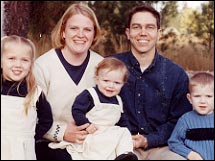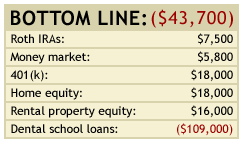BEND, Ore. (CNN/Money) –At the end of each year, just in time for New Year's resolutions, Brad Jarvis does a sobering exercise: He calculates his net worth.

"Right now we're about $44,000 in the hole," said the 33-year-old Spokane, Wash. dentist.
That's progress considering that last year at this time, Brad and his wife, Lori, had a negative net worth of $97,000, thanks to Brad's student loans. In fact, when Brad graduated from Case Western Reserve University's dental school in 2000, the couple walked away with $126,000 in student loans and very little savings to speak of.
In exchange for a hefty chunk of debt, however, Brad took with him the training to build a stable and lucrative career. Just three years out of dental school, his gross income is $130,000. After supporting Brad during dental school, Lori, 29, is now a full-time mother of Lindsey, 5, Daniel, 3, and Savannah, 1.
| More Millionaire profiles
|

|
|
|
|
By living modestly, the Jarvises' stretch their single income to its fullest. Even after tithing 10 percent to their church, the couple manages to save more than $20,000 a year and pay down $15,000 of student loans annually. On top of that, they're building equity in both their home and a rental property they bought last year.
"It's really encouraging to get a monthly update on my accounts and see we're that much closer to having a positive net worth," said Brad.
The art of multitasking
Initially, Brad and Lori focused almost exclusively on paying off Brad's student loans. Saving, they thought, would just have to wait.
"Then I read the book, 'Rich Dad, Poor Dad' and that really got me thinking," said Brad of the book, which contrasts how the wealthy and the middle class manage their money. "Until then I hadn't really thought a lot about planning for the future."

"In my family we didn't talk about money or the consequences of spending and not saving," he added. "My wife comes from a family that is very financially conscious."
Indeed, planning for the future wasn't such a novel concept for Lori. She opened a savings account at age 10 and put away enough babysitting money to pay for half of her freshman year of college.
"My parents had us pay for half of everything, including college, even though they could afford to pay for it all," she said.
A year and a half ago, Brad and Lori began taking steps to boost their own net worth.
The first thing they did was start contributing to Brad's 401(k), which gets a 4 percent match from the dental practice where he works. Already, his balance is about $18,000, and he's adding about $12,000 a year to that amount by contributing the maximum amount.
Then he and Lori opened Roth IRAs, to which they each contribute $3,000 a year – again, the maximum amount allowed.
Also, they began socking away $200 each month into a money market account earmarked for a new car and available for emergencies.
"Both of our cars are paid off but we make a $200 a month payment to a money market account so that if our car breaks down we have the money for a car," said Brad.
Saving doesn't mean turning a blind eye to Brad's student loans. Last year, Brad refinanced his 30-year student loan to a 10-year loan by selling his debt to his father-in-law, who earns 5.75 percent interest.
The $1,250 monthly payment they make to Lori's dad is steep, but will bring Brad's dental school balance to nil in nine years.
Saving on shelter
In order to save as they do and aggressively pay off Brad's student loans, the Jarvises' must keep close tabs on their expenses, beginning with what is the largest expense for most families, shelter.
"The bank approved us for two times the amount of this house, but we decided to go with something more conservative," said Brad of their four-bedroom, three-bath house for which they paid $143,000.
Because they had only 5 percent of the home's price at the time they bought it, the couple pays an extra $200 a month (twice the minimum due) toward the "piggyback" loan they took out to avoid paying private mortgage insurance (PMI). Still, their total monthly housing costs, including taxes, insurance and payments for the additional loan; add up to less than $1,000.
By taking a conservative route with their own home, the couple was able to buy a $94,000 duplex near Gonzaga University last year, all but guaranteeing a steady stream of renters. After paying the mortgage, taxes, utilities and insurance, the Jarvises' earn $170 a month on the property, which has already appreciated by more than $6,000.
Between loans, savings and tithing to their church, the couple doesn't have a lot of discretionary income left over. "We don't eat out a lot," said Brad. "And if we do go on vacation we try to drive instead of fly."
They're also holding off saving for their children's college education. "Because of my earning potential as time goes on, I'm less concerned about saving for college right now," said Brad.
The ten-year plan
The Jarvises' next big financial move is likely to come in a year or two when Brad buys into the dental practice where he now works. As a partner, he has the potential to double, even triple his current salary.
Initially, the extra income he makes as a partner will go directly toward paying the $400,000 to $500,000 practice loan he'll need to pay for the partnership.
But by his calculation, Brad will own his share of the practice free and clear within 10 years from now – about the same time he pays off his student loans.
"That's a day we look forward to with great anticipation," he said.
 |
YOUR E-MAIL ALERTS
|
Follow the news that matters to you. Create your own alert to be notified on topics you're interested in.
Or, visit Popular Alerts for suggestions.
|
|
|
To be sure, once student loans are out of the way and Brad's share of his dental practice is paid for, the Jarvises' disposable income is likely to increase by $10,000 a month.
"I'm sure we'll take a little of that money to live more comfortably," said Brad. "But the majority will go to retirement and the kids' education."
Assuming they don't dramatically change their saving and spending habits, the Jarvises' will not only be in the black at that point, they'll be on the fast track to a seven-figure net worth.

|

